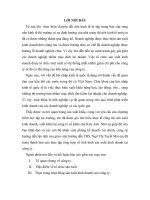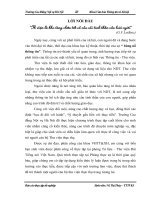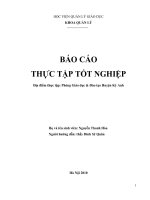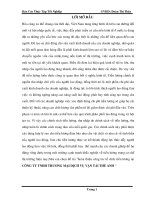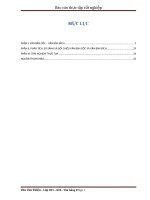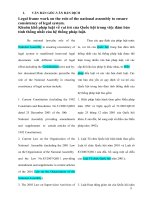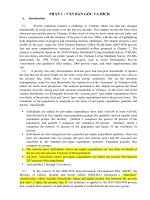Báo cáo thực tập tốt nghiệp tiếng anh (30)
Bạn đang xem bản rút gọn của tài liệu. Xem và tải ngay bản đầy đủ của tài liệu tại đây (209.25 KB, 51 trang )
ACKNOWLEDGEMENTS
For the completion of this work, I have been fortunate to receive
invaluable contributions from many people.
First of all, I would like to express my deepest gratitude to my
supervisor, Nguyễn Thị Tường, M.A. for guiding me to do research and
giving me many advices and suggestions.
I would also like to extend my sincere thanks to my teachers in
Foreign Languages Department, my family and my friends for their
various kind of help and encouragement.
Vinh, May 2010
Pham Thi Thuy Dung
i
ABSTRACT
Communicating is an important part of daily life. People must talk
to each other to work and sastify their own communicating need.
Invitation is a popular speech act in daily conversation. But how to
achieve the goals of invitation politely and avoid putting hearer and
speaker in difficult position, using pre-invitation is a solution . This
research presents pre-invitation, its functions and some common forms. Many
examples were collected from many books, stories and documents to explain
more clearly. Finally, some main similarities and differences in preinvitation between English and Vietnamese are pointed out.
ii
TABLE OF CONTENTs
pag
e
iii
ABBREVIATION
CA : contrastive analysis
Fig. : figure
e.g : for example
FTA: face threatening act
H’s: his or her
i.e. : that is to say
T : turn
iv
PART A: INTRODUCTION
1. Reasons for choosing the topic
In communication, participants always try to achieve something in their
turns. To achieve the goals of communication, speakers usually try to plan
their actions logically and use the communicating strategies through speech
acts. In conversation, we must use some certain kinds of speech acts which
are likely to threaten another’s face. To reduce the greatest risk, people often
use many strategies. One of these strategies is using pre-sequences. However,
in text books for pupils, pre-sequences are not often presented. For example, a
conversation is used to teach about how to make an invitation, often just
present the inviting act only.
A : Let’s go to the movie tonight.
B : I have to study for an exam.
Terasaki (1976) has pointed out, in ordinary conversation invitations
are not made in simple pairs such as invitation and denial or invitation and
acceptance. More routinely, the inviter issues a pre-invitation in order to find
out what likely result of any subsequent invitation will be.
A : What are you doing tonight? (pre-invitation)
B : Not much. (positive response to project invitation)
A : How about a movie? (invitation)
The reason of writer for doing this study is to give knowledge to the
readers about the pre-sequences, especially, pre-invitation. From this study,
the writer hopes that it can give description of what is meant by pre-invitation
especially in helping people for better arranging and understanding
conversations.
2. Aims of the study
This study helps the readers understanding about the meaning of preinvitation and its usage in conversation. The writer wants to describe the
1
forms and functions of pre-invitation in order to help the readers to organize a
better conversation, especially, when they want to make an invitation, to
achieve the best result as well as to avoid putting participants in difficult
position.
3. Scope of the study
This study focuses on the utterances which contain pre-sequences,
especially, pre-invitation. The writer only presents some main purposes of
using pre-invitation and its common forms with the examples in both English
and Vietnamese.
4. Methods of the study
To conduct the study, we have used the following methods:
−
Analysis
−
Statistics
−
Comparative and contrastive methods
5. Design of the study
The thesis comprises three main parts:
Part A : Introduction
This part presents the reasons for choosing the topic, aims, scope,
methods and format of the study.
Part B : Development
This is the main part of this study devided into three chapters:
Chapter I:
Theoretical background.
Chapter II:
Pre-invitation in English and Vietnamese
Chapter III:
Some similarities and differences
Part C: Conclusion
This part reviews major findings of the thesis and suggests some directions
for further study.
2
PART B: DEVERLOPMENT
CHAPTER I: THEORETICAL BACKGROUND
1.1.
Speech acts
To understand about speech acts, we will examine the origin of the
concept “speech acts”. The idea of speech acts has its roots in the Philosophy
of Language. J. A. Austin was the first person who wanted to capture the fact
that there is more in the function of language than semantics. Traditionally,
mapping of entities of a proposition onto referents and defining the truth value
of a proposition was the major area of interest in language semantics. With
Austin, and his follower J. R. Searle, there is a shift towards the events or acts
that occur via language, it is called “speech acts”. These acts effect changes
both in the observable world, as well as in the mental states of dialogue
participants. Austin's approach introduces pragmatics in studying and
modeling language. Consequently, the focus is now on utterances and not
propositions.
Speech acts play an important role in everyday conversation. They
became a topic of sustained investigation, at least in the English-speaking
world, in the middle of the Twentieth Century. Since that time “speech act
theory” has been influential not only within philosophy, but also in linguistics,
psychology, legal theory, artificial intelligence, literary theory and many other
scholarly disciplines. Recognition of the importance of speech acts has
illuminated the ability of language to do other things than describe reality. In
the process the boundaries among the philosophy of language, the philosophy
of action, the philosophy of mind and even ethics have become less sharp.
According to Yule (1996: 47) “actions performed via utterances are
generally called speech acts”. The philosopher J.L. Austin considered speech
acts as “utterances (things people say) are equivalent to actions”. When
someone says: “I name this ship” or “I now pronounce you man and wife”, the
3
utterance creates a new social or psychological reality. We perform speech
acts when we offer an apology, greeting, request, complaint, invitation,
compliment, or refusal. A speech act is an utterance that serves a function in
communication. A speech act might contain just one word, as in “Sorry!” to
perform an apology, or several words or sentences: “I’m sorry I forgot your
birthday”. I just let it slip my mind.". Speech acts include real-life
interactions and require not only knowledge of the language but also
appropriate use of that language within a given culture.
1.1.1. Structure of speech act
According to Austin, there are three types of acts that can be performed
by every utterance, given the right circumstances: locutionary, illocutionary
and perlocutionary acts.
• Locutionary act is simply the speech acts that have taken place. It is
the basic act of utterance or producing a meaningful-linguistic expression.
Making an utterance, the speaker performs a locutionary act that is an act of
saying something with a determinate sense and reference. According to
Austin, locutionary act expresses the meaning of the statement itself. For
example, when saying “step back”, speaker want to tell someone step back.
• Illocutionary acts are the real actions which are performed by the
utterance, where saying equals doing, as in betting, plighting one’s troth,
welcoming and warning. The illocutionary act is not in one-to-one
correspondence with the locution from which it is derived. There are different
locutions that express the same illocution and vice-versa. For example, there
are indirect speech acts, that is acts with a different force than the obviously
deducible one. A typical example is the locution of the utterance “Could you
pass the salt?” uttered at a dinner table. For a speaker of English in the
particular situation this means “Pass the salt, please” and no one would
assume that the speaker is indeed interested in whether the hearer would be
able to pass the salt.
4
• Perlocutionary acts are the effects of the utterance on the listener.
Depending on the kind of perlocution, different conditions have to hold in
order for it to be achieved. In other word, depending on the circumstances,
you will utter on the assumpsion that the hearer will recognize the effect you
intended. For example, the hearer in the salt example has to realise that the
speaker's intention is to ultimately get hold of the salt.
The most discussed act among these three dimentions is illocutionary
act, especially, illocutionary force. Indeed, the term “speech acts” is generally
interpreted narrowly to mean only the illocutionary force of an utterance.
1.1.2. Classification of speech acts
In 1975, Searle suggested the following classification of speech acts:
•
Assertives (Representatives)
They commit the speaker to something being the case. Those the
different kinds are: suggesting, putting forward, swearing, boasting,
concluding.
No one makes a better cake than me.
It was a nice day.
•
Directives
They try to make the addressee perform an action. In other wosds,
speaker use these kinds of speech acts to get somone to do something. The
different kinds are: asking, ordering, requesting, inviting, advising, begging.
Could you close the window?
Would you like to have a cup of coffee?
•
Commisives
They commit the speaker to doing something in the future. The different
kinds are: promising, planning, vowing, betting, opposing.
I'm going to Paris tomorrow.
I’ll be back.
•
Expressives
5
They express how the speaker feels about the situation. The different
kinds are: thanking, apologising, welcoming, deploring.
I am sorry that I lied to you.
Congratulation!
•
Declarations
They change the state of the world in an immediate way. The speaker
has to have a special institutional role, in a specific context, in order to
perform a declaration appropriately.
Boss : You are fired!
Priest: I now pronounce you are husband and wife.
Referee : you’re out !
1.2. Politeness
According to Yule (1996 : 60) politeness is treated “as a fixed concept,
as in the idea of polite social behavior, or etiquette, within a cuture. It is also
possible to specify a number of different general priciples for being polite in
social interaction within a particular culture. Some of these might include
being tactful, generous, modest, sympathetic toward others”.
Yule defined politeness “as the means employed to show awareness of
another person’s face”. We will discuss deeplier person’s face and its
definition in the following parts. It is also considered as “…what we think is
appropriate behaviour in particular situations in an attempt to achieve and
maintain successful social relationships with others.” (Lakoff 1972: 910)
Another linguistic, Leech defined politeness as forms of behaviour
that establish and maintain comity. That is the ability of participants in a
social interaction to engage in interaction in an atmosphere of relative
harmony. Leech (1983:16) stated the politeness principles which can help the
participants “minimize the expression of impolite beliefs”. In stating his
6
maxims Leech uses his own terms for two kinds of illocutionary acts. He calls
representatives “assertives”, and calls directives “impositives”.
Below are some characteristics of Leech’s maxims:
• Tact maxim (in impositives and commissives) states: “Minimize the
expression of beliefs which imply cost to other; maximize the expression of
beliefs which imply benefit to other”. The first part of this maxim fits in with
Brown and Levinson's negative politeness strategy of minimising the
imposition, and the second part reflects the positive politeness strategy of
attending to the hearer's interests, wants, and needs. This maxim can be divide
into 2 submaxim:
a) minimize cost to other
b) maximize benefit to other.
• Generosity maxim (in directives and commissives) states: “Minimize
the expression of benefit to self; maximize the expression of cost to self”.
Unlike the tact maxim, the maxim of generosity focuses on the speaker, and
says that others should be put first instead of the self. This maxim can be
divide into 2 submaxim:
a) minimize benefit to self
b) maximize cost to self.
• Approbation maxim (in expressives and assertives) states: “Minimize
the expression of beliefs which express dispraise of other; maximize the
expression of beliefs which express approval of other.” This maxim can be
divide into 2 submaxim:
a) minimize dispraise of other
b) maximise praise of other
• Modesty maxim (in expressives and assertives) states: “Minimize the
expression of praise of self; maximize the expression of dispraise of self.”
This maxim can be divide into 2 submaxim:
7
a) minimize praise of self
b) maximize dispraise of self
• Agreement maxim (in assertives) runs as follows: “Minimize the
expression of disagreement between self and other; maximize the expression
of agreement between self and other.” This maxim can be divide into 2
submaxim:
a) minimize disagreement between self and other
b) maximize agreement between self and other
• Sympathy maxim (in assertives) states: “minimize antipathy between
self and other; maximize sympathy between self and other”. This includes a
small group of speech acts such as congratulation, commiseration, and
expressing condolences - all of which is in accordance with Brown and
Levinson's positive politeness strategy of attending to the hearer's interests,
wants, and needs. This maxim can be divide into 2 submaxim:
a) minimize antipathy between self and other
b) maximize sympathy between self and other
Leech does not weigh all maxims the same. He considers the Tact and
the Approbation maxim to be more important than the Generosity and
Modesty maxim, because he believes that politeness is generally more
oriented towards the other than the self. Additionally, Leech considers the
submaxims a) to be more important than the sub-maxims b).
In conversation, participants usually try to be polite by following the
politeness principle. The goal of politeness is to make all of the parties
relaxed and comfortable with one another.
Talking about politeness theory, we should mention lakoff’s politeness
rules, Lakoff proposed the following “Rules of Politeness”:
1. Formality: keep aloof.
2. Deference: give options
3. Camaraderie: show sympathy
8
Lakoff sees the first rule as the most prominent one in formal politeness
(Lakoff 65). It creates distance between the speaker and the addressee by
many different means of achieving distance such as using formal words,
hypercorrect forms and avoidance of colloquialism. The application of the
second rule makes it look as though the option as to how to behave, or what to
do, is being left up to the addresse. Examples of Rule two would be
hesistancy in speech or action, as well as the the use of tag questions,
suggesting that the speaker is uncertain about the truth of his assertion, and
the use of hedges. Aspects of Rule 3 are gestures of friendliness. The purpose
of Rule 3 is to make the addressee feel that the speaker likes him.
1.3. Face wants
1.3.1. Definition of face
Face, as a technical term, means the public self-image of a person. This
is emotional and social sense of self that every person has and expects
everyone else to recognize.
In communication, to make the hearer comfortable and to achieve their
own goals of communication, speakers should pay much attention to the
hearer’s face. Therefore, in conversation, speakers usually try to plan their
actions in a way to redress their partners’ face wants and avoid saying
something that can threaten another’ face. In everyday social interactions,
people generally behave in the ways that their expectations concerning their
public self-image will be respected. Their expectations are called face wants.
Face threatening act
If someone say something that represents a threat to another person’s
self image that is called a face threatening act. For example, if you use a
direct speech act to older, “Give me the pen !”, you are acting as if you have
more social power then you are performing a face threatening act.
9
Face saving act
Whenever you say something that lessens the posible threat to another
face, it is called a face saving act. Beacause it is generally expected that each
person will attempt to respected the face wants of others, there are many
different ways of performing face saving acts.
1.3.2. Positive and negative face
The concept “face” consists of two related aspects: negative face and
positive face.
Negative face
According to Yule (1996), a person’s negative face is the need to be
independent, to have freedom of action, and not to be imposed by others. In
other words, negative face is reflected in the desire not to be impeded or put
upon, to have freedom to act as one chooses.
Brown and Levinson (1987) stated that negative face is “the basic claim
to territories, personal pre-sereves, rights to non-distraction, i.e., to freedom of
action and freedom from imposition”
Positive face
Positive face is “the need to be accepted, event liked, by other, to be
treated as a member of the same group, and to know that his or her wants are
shared by other” (quoted in Yule, 1996).
Brown characterized positive face by the desire that to be like, admired,
valued, respected, approved of, and appreciated by others. At the same time,
she characterized negative face by the desire not to be imposed upon. Positive
face refers to one's self-esteem, while negative face refers to one's freedom to
act.
Positive and negative face are the two aspects of face that are the basic
wants in any social interaction, and so during any social interaction,
cooperation is needed amongs the participants to maintain each others' faces.
The rational actions people take to preserve both kinds of face, for themselves
10
and the people they interact with, add up to politeness. Brown and Levinson
also argued that in human communication, either spoken or written, people
tend to maintain one another’s face continuously.
1.4. Politeness strategies
The theory claims that most speech acts threaten either the hearer’s
or speaker’s face-wants, and that politeness is involved in redressing those
face-threats (Eelen 2001: 4).
The chart below shows that the speaker has a set of strategies
available to redress FTAs, which are mutually known to both speaker and
addressee.
Circumstances determining choice of strategy
Lesser
1. without redressive action baldly
on record
Do the FTA
2. positive politeness
with redressive action
4. off record
3. negative politeness
5. Don’t do the FTA
Greater
Figure1:Possible Strategies for realising FTAs
(Brown and Levinson 1987:60)
The strategy, which a speaker may choose, depends on how high the
speaker considers the risk of face-threat to be (Fig. 1). The first strategy is a
straightforward, unambiguous utterance, which does not redress FTAs at all.
Strategies 2 and 3 result in positive politeness (expression of solidarity and
minimising status differences) or negative politeness (expression of restraint,
paying people respect and avoiding intruding on them). Strategy 4 (offrecord) means that there is more than one possible interpretation of an
11
utterance, i.e. there is an open way out for both the hearer and the speaker.
Strategy 5 (do not do the FTA) is chosen when the risk is considered too great
to actually do the FTA (Locher 2004:68).
There are four types of politeness strategies, described by Brown and
Levinson, that sum up human "politeness" behavior: Bald On Record,
Negative Politeness, Positive Politeness, and Off-Record-indirect strategy
Bald on record
Bald on record is strategy which provides no effort to minimize threats
to the hearer’s face. These provide no effort by you to reduce the impact of
the FTA's. You will most likely shock the person to whom your are speaking
to, embarrass them, or make them feel a bit uncomfortable. However, this
type of strategy is commonly found with people who know each other very
well, and are very comfortable in their environment, such as close friends and
family. Let’s see in some specific examples below:
An Emergency: Help!!!
Task oriented: Give me that!
Request: Put your coat away.
Alerting: Turn your headlights on!
Positive politeness
According to Brown and Levinson (1987:101), “positive politeness is
redress directed to the addressee’s positive face, his perennial desire that his
wants (or the actions/acquisitions/values resulting from them) should be
thought of as desirable. Redress consists in partially satisfying that desire by
communicating that one’s own wants (or some of them) are in some respects
similar to the addressee’s wants”. This strategy leads the speaker to appeal to
a common goal, and even friendship, via expression as the below examples:
a. How about letting me use your pen?
b. Hey, buddy, I’d appreciate it if you would let me use your pen.
12
Positive politeness is usually used among groups of friends or where
people in the given social situation know each other fairly well. It usually tries
to minimize the distance between them by expressing friendliness and solid
interest in the hearer's need to be respected (minimize the FTA).
• Attend to the hearer: “You must be hungry, it's a long time since
breakfast. How about some lunch?”
• Avoid disagreement: A: “What is she, small?” B: “Yes, yes, she's
small, smallish, um, not really small but certainly not very big.”
• Assume agreement: “So when are you coming to see us?”
• Hedge opinion: “You really should sort of try harder.”
Negative politeness
According to Brown and Levinson (1987:70), negative politeness is “
oriented mainly toward partially redressing H’s negative face, his basic want
to maintain claims of territory and self-determination. Negative politeness,
thus, is essentially avoidance-based, and realization of politeness negative
strategies consist in assurances that the speaker recognizes and respects the
addressee’s negative face wants and will not (or will minimally) interfere with
the addressee’s freedom of action”
•
Be indirect: “I'm looking for a comb.”
•
Forgiveness: “You must forgive me but....”
•
Minimize imposition: “I just want to ask you if I could use your
computer?”
•
Pluralize the person responsible: “We forgot to tell you that you
needed to by your plane ticket by yesterday.”
Off record (indirect)
You are removing yourself from any imposition whatever.
•
Give hints: “It’s cold in here."
•
Be vague: “Perhaps someone should have been more
responsible.”
13
•
Be sarcastic, or joking: “Yeah, he's a real rocket scientist!”
1.5. Pre-sequence
A sequence is a unit of conversation that consists of two or more
adjacent and functionally related turns. In other words, sequences are turns of
talk from the beginning to the end of action (Schegloff, 1995).
Pre-sequence is a sequence which includes a turn recognizable as
potential initiation of another specific type of turn. Pre-sequence means
certain utterances came before the other utterances which is in the beginning
of a conversation or certain utterances belong to the opening sequence of a
conversation. Pre-sequence occupy a position of the speaker and the hearer in
order to differentiate between the formal and informal conversation. It means
that the speaker and the hearer can arrange their conversation by themselves
into formal and informal through the pre-sequence utterances by them.
Let’s examine pre-sequence result in following structures:
−
Turn 1 : an initiation (“question”) checking whether some precondition
obtains for the action to be performed in turn 3
−
Turn 2 : a response (“answer”) indicating that/whether precondition
obtains, often with question or request to proceed to turn 3
−
Turn 3 : the prefigured action, conditional on the ‘go ahead’ in Turn 2.
or: turn 3′ if discouraged, intended action withheld (+optional
explanation of turn 1 in terms of what would have been done)
−
Turn 4 : a follow-up response to action in Turn 3
Distribution rule : one party A addresses T1 and T3 to another party B, and B
Addresses T2 and T4 to A.
There are many types of pre-sequences, we can examine some common
types of pre-sequences as below:
−
Pre-invitation (e.g. Are you free tonight?)
−
Pre-announcement (e.g. You won’t believe this.)
−
Pre-arrangement (e.g. Would you like to make an appointment later on?)
14
−
Pre-request (e.g. Do you have coffee to go?)
−
Pre-closing (e.g. Okay.)
1.5.1. Functions of pre-sequences
Actually, the function of pre-sequence is showing how speakers have
taken on the ideas that the talk is sequential, one thing after another, and how
they are careful in the order in which they present possiblities.
Besides, pre-sequences became delivering tool of a message to give
information about the main point conversation in order to be more specific.
Then, pre-sequence also has the important role in arranging and managing the
conversation. Moreover, pre-sequences can be used for inquiring about status
of the speaker or the hearer, status of situation and others.
Other fuction of pre-sequence is that it is used by participants in
conversation to draw hearer’s attention to or prepare the ground for the kind
of turn that are going to take next.
1.5.2. Somes types of pre-sequences
The pre-sequences are divided into many types namely : pre-request,
pre-invitation,
pre-announcement,
pre-arrangement,
and
pre-closing
(Levinson 1983:345)
∗ Pre-announcement
A pre-announcement is a pre-sequence for an announcement of news.
It is “generally for delivering an newsworthiness of potential announcement,
for validating newsworthiness in order to check someone attenton that comes
before the main announcement” (Levinson 1983:349)
Child
: Mom, guest what happened?
Mother : (silence)
Child
: Mom, you know what?
Mother : Not right now, Jacy, I’m busy.
15
∗ Pre-arrangement
A pre-arrangement is a pre-sequence in which an attempt is made to
arrange for later contact, as by means of a question-answer sequence
determining the availability of one of the participants.
A: Erm, what are you doing today?
B: Er, well, I’m supervising at quarter past.
A: Er, yuh, why don't, er, would you like to come by after that?
B: I can't, I'm afraid, no.
∗ Pre-request
A pre-request is a pre-sequence that prefigures a request, possibly by
ascertaining the ability of the respondent to satisfy the coming request.
A: Are you busy?
B: Not really.
A: Check over this memo.
B: Okay.
∗ Pre-closing
A pre-closing is a pre-sequence that signals the end of a conversation is
near. It provides opportunity for the discussion of any additional remaining
topic before the participants proceed with the closing sequence.
A: Okay?
B: Okay.
A: Bye.
B: Bye
∗ Pre-invitation :
A pre-invitation is a pre-sequence that is likely to be understood by the
respondent as a signal of a coming invitation. The coming invitation may be a
question-answer sequence concerning the availability of the participant to be
invited.
16
Him : What are you doing this Friday?
Her : Hmm, nothing so far.
Him : Come over for dinner.
Her : Oh, I’d like that.
This type of pre-sequence will be discussed more detail in the next
chapter.
1.6. A brief overview of Contrastive Analysis
Contrastive analysis (CA) is the systematic study of a pair or more of
languages with a view to identifying their structural differences and
similarities.
Contrastive Analysis is the method of analysing the structure of any
two languages with a view to estimate the differential aspects of their
systems, irrespective or their generic affinity or level of development.
Contrastive analysis of two languages becomes useful when it is adequately
describing the sound structure and grammatical structure of two languages,
with comparative statements, giving due emphasis to the compatible items in
the two systems.
A systematic comparative study analyzing component wise the
differences and similarities among languages was clearly recognized toward
the end of 19th century and the beginning of 20th century. The term
‘Contrastive linguistics’ was suggested by Whorf (1941) and was defined as
“a sub discipline of linguistics concerned with the comparison of two or more
languages or subsystems of languages in order to determine both the
differences and similarities between them” (Fisiak 1981:1).
Contrastive Analysis is not only very important for teaching and
learning second language but it can also make useful contributions to machine
translating and linguistics typology. Contrastive Analysis is the useful method
for linguistic study.
17
CHAPTER II: PRE-SEQUENCE IN INVITATION OR PREINVITATION IN ENGLISH AND VIETNAMESE
2.1. Pre-invitation
As introduced above, one type-specific pre-sequences is the preinvitation. This often placed near the opening of a conversation but could be
placed sequentially before the closing. “Are you doing anything? What are
you doing this weekend?” are typical pre-invitation (Scheloff, 1995). Terasaki
(1976) has point out, in ordinary conversation invitations are not made in
simple pairs such as invitation and denial or invitation and acceptance.
A : Let’s go to the movie tonight.
B : I have to study for an exam.
More routinely, the inviter give a pre-invitation in order to find out
what likely result of any subsequent invitation will be.
A : What are you doing tonight. (pre-invitation 1)
B : I have to study for an exam. (negative response)
A : How about Wednesday?
Or
(pre-invitation 2)
A : What are you doing tonight? (pre-invitation)
B : Not much.
(positive response to project invitation)
A : How about a movie? (invitation)
B : Okay.
(acceptance)
2.1.1. Definition of pre-invitation
A pre-invitation is a pre-sequence that is likely to be understood by the
respondent as a signal of a coming invitation. The coming invitation may be a
question-answer sequence concerning the availability of the participant to be
invited (cited by Levinson, 1983). In others word, pre-invitation is a way to
get ideas about how participant will respond to an invitation.
A: Hi, John.
18
B: Say, what’re you doing?
A: Well we’re going out. Why?
B: Oh, I was just gonna say come over here this evening.
Pre-invitation is commonly used in making invitation treated as
transparent by the hearer so the responses clearly attuned to the fact that an
invitation (or related act) (Levinson 1983:346).
In Viet Nam, Nguyen Thien Giap (2000) defined pre-invitation as the
words used to visualize the ability of the action. And below is his example of
pre-invitation :
A : Tối nay anh có làm gì khơng?
B : Khơng. Thế thì sao?
A : Đến tơi chơi cờ đi.
There are many ways to make an invitation but how to avoid the risk of
this action. Using pre-invitation is a safety solution to avoid the risk and
makes both speaker and hearer more comfortable in conversation.
2.1.2. Positions of pre-invitation
2.1.2.1. Before invitation
Pre-invitation often precedes invitation in everyday conversation.
Therefore, we often see it before invitation than after invitation.
(1) Pre-sequence and invitation are in the same turn.
−
pre-invitation, invitation
−
response
Em đi có một mình à? Ta vào kia uống cà phê đi.
In this situation, some functions of pre-invitation seems to be lost
because there is no place left after the pre-invitation for a reply. Pre-invitation
should be responded to in order for the participant to be able to decide
whether or not to go ahead and make the invitation.
- You must be hungry, it's a long time since breakfast. How about some
lunch?
19
- Sounds like a good idea.
(2)pre-sequence and invitation are in the separate turns:
−
pre-invitation
or
pre-invitation
−
go-ahead
stop
−
invitation
(invitation is not made)
−
response
A : What are you doing tonight? (pre-invitation)
B : Not much.
(go- ahead)
A : How about a movie?
(invitation)
B : Okay.
(response)
In this situation, pre-invitation helps the participant to be able to decide
whether or not to go ahead and make invitation. After the pre-invitation, the
hearers will give a sign to show how they might respond to projected
invitation. If the hearer gives the “go-ahead” sign, speaker will decide to
make invitation. In contrast, if the hearer gives a “stop” response, speaker will
not make invitation.
−
Tơi có hai vé xem phim tối nay. (pre-invitation)
−
Ngày mai tôi thi.
(stop)
(2’) there are more than one pre-sequence
−
pre-invitation 1
−
negative response
−
pre-invitation 2
−
go-ahead
−
invitation
−
response
If the first turn of checking some precondition for the action is replied
by a negative response (stop sign) and the speaker still want to check for other
options he/she will gives another pre-sequence.
A : What are you doing tonight. (pre-invitation 1)
20
B : I have to study for an exam. (negative response)
A : How about Wednesday?
(pre-invitation 2)
2.1.2.2. After invitation
When pre-invitation appears after invitation, it often has one certain
function, that is persuade or encourage the hearer to accept the invitation. This
phenomenon is often seen in Vietnamese and is a special position of presequence. In this case, pre-invitation is often given right after the invitation.
-Em chỉ thèm một ly cà phê.
- Vậy thì ra qn. Ở ngồi cổng có một qn khá lắm.
- Để em vào xin mẹ đã.
(Nguyễn Hải, 1992)
- Dine with me and Fritz at the inn in the park. We will have roast
pheasants and porter, plum-pudding and French wine.
In some cases, we can change pre-invitation’s position from before
invitation to after invitation and vice versa, without changing its meaning.
- Em mới tìm ra một hàng ăn ngon lắm! Ta đi ăn nhé!
- Để khi khác, muộn mất rồi. Bây giờ anh muốn nghe em nói chuyện
Or:
- Ta đi ăn nhé! Em mới tìm ra một hàng ăn ngon lắm!
- Để khi khác, muộn mất rồi. Bây giờ anh muốn nghe em nói chuyện
Thus, pre-invitation will appear in different positions, depending on
speaker’s purposes.
2.2. Pre-invitation in politeness strategy
During conversation, participants always try to achieve something in
their turns. To achieve the goals of communication, speakers usually try to
plan their actions logically, the participants should predict the others’
attentions through their utterances than understand the meaning of the words
only. Similarly, when speakers wants to invite someone to do something, they
must consider carefully before making an invitation in order to achieve their
goals.
21

